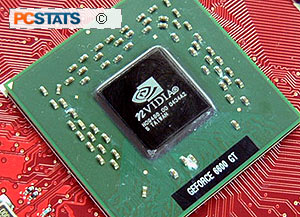 There's been a lot of focus lately on
how mainstream ATi and nVIDIA cards only have half the rendering pipelines of
their high end counterparts. Let's remember something; both the NV43 and R410
have eight pixel rendering pipelines. This is the same number as on the Radeon
9800XT, and twice that of the GeForceFX 5950 Ultra. Both those cards are still
pretty fast. That should already tell you that performance will be good.
Right?!
There's been a lot of focus lately on
how mainstream ATi and nVIDIA cards only have half the rendering pipelines of
their high end counterparts. Let's remember something; both the NV43 and R410
have eight pixel rendering pipelines. This is the same number as on the Radeon
9800XT, and twice that of the GeForceFX 5950 Ultra. Both those cards are still
pretty fast. That should already tell you that performance will be good.
Right?!
As mentioned earlier, the GeForce 6600GT (NV43)
core is built on IBM's 0.11 micron manufacturing process and contains a whopping
146 million transistors. nVIDIA has cut the vertex pipelines from the six found
in the GeForce 6800 class cards to three in the GeForce 6600GT. To economize
further, the memory controller has also been cut to 128bit. This means that at
high resolutions with AA/AF enabled, the NV43 will not be able to handle the
load as well as its more expensive sibling.
There are two models of the NV43
core, the GeForce 6600GT and plain GeForce 6600. The 'GT' that we're testing now has
a core clock speed of 500 MHz, and memory running at 1 GHz. The vanilla
Geforce 6600 version runs at 300 MHz core / 500 MHz memory. Both cards support all
the latest DirectX 9.0C fun, as well as nVIDIA's Shader Model 3.0.
While the GeForce
6600GT core is technically SLI compatible, the card is not since it uses an AGP interconnect.
This shouldn't be much of a surprise though. No SLI connector is present on the
card for obvious reasons.
Overclocking the MSI NX6600GT-VTD128!
As the benchmarking began on
the MSI NX6600GT-VTD128, we noticed that performance was extremely high even
though the card is supposed to be clocked at a standard 500 MHz core, 900 MHz
memory. After playing around a bit, I realized that the videocard was actually
running at 578/1073, the maximum overclocked speed that the previous nVidia
based card we reviewed, the Albatron Trinity GeForce 6600GT AGP, was able to
achieve! It looks like the Detonator drivers didn't reset the speed even though
a new card was being used.
 Of course we were
very pleased to see the MSI NX6600GT-VTD128 running well at 578MHz core, 1073MHz
memory (and our job was made much easier). We didn't stop here though; instead
we tried raising the clock speed of the core just a bit more.
Of course we were
very pleased to see the MSI NX6600GT-VTD128 running well at 578MHz core, 1073MHz
memory (and our job was made much easier). We didn't stop here though; instead
we tried raising the clock speed of the core just a bit more.
This little adventure didn't
go very far however... Anything higher than 581 MHz and the core would start to
produce green artifacts when running 3DMark2001. I think its problems may have
been due to heat, but unfortunately we didn't have any third-party GPU coolers
handy so we gave up at that speed.
The MSI NX6600GT-VTD128 uses
the same Samsung memory as the Albatron card so we didn't expect it to overclock
much higher either. To our surprise, the 2.0ns Samsung K4J55323QF-GC20 memory
was able to hit a very nice 1085 MHz. We did try to get it past 1.1 GHz, but
when we did so we encountered snow on some of the benchmarks.
 |
| PCStats Test System Specs: |
|
system 1 |
system 2 |
| processor: |
intel pentium 4 540 |
intel pentium 4 3.0c |
| clock
speed: |
16 x 200 mhz = 3.2 ghz |
15 x 200 mhz = 3.0 ghz |
| motherboards: |
gigabyte 8anxp-d, i925x |
gigabyte 8knxp, i875p |
| videocard: |
gigabyte gv-rx60x128v
gigabyte gv-nx57128d
msi
pcx5750-td128
albatron trinity pc5900
asus extreme eax600xt
gigabyte gv-rx70p256v
gigabyte gv-nx66t128d |
ati radeon 9800xt
ati radeon 9800 pro
ati
radeon 9700 pro
asus radeon
9600xt
albatron geforce 6800gt
asus v9999 gamer edition
albatron trinity
geforce
6600gt
msi fx5950 ultra-td128
msi fx5900u-vtd256
msi
fx5900xt-vtd128
aopen geforcefx 5900xt
msi nx6600gt-vtd128 |
| memory: |
2x 256mb crucial ballistix
ddr2 |
2x 256mb corsair twinx
3200ll |
| hard
drive: |
40gb wd special ed
|
40gb wd special ed
|
|
cdrom: |
gigabyte dvd burner |
msi x48 cd-rw/dvd-rom |
| powersupply: |
vantec stealth 470w |
vantec stealth 470w
|
|
software setup |
windowsxp build 2600
intel inf 6.0.1012
catalyst 4.11
detonator
66.93 |
windowsxp build 2600
intel inf 6.0.1012
catalyst 4.11
detonator
66.93 |
|
benchmarks |
3dmark2001se
3dmark05
codecreatures
aquamark
gun metal 2
x2 the threat
ut2003
doom3
aa test, af and
aa+af test
3dmark2001se
x2 the threat
ut2003 |
|
the agp and
pci-e systems are different, but the results are included for
reference.
